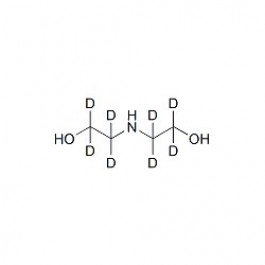New user? / Forgot your password?
0 Item | 0,00 €
Need NMR solvents or supplies? Click here and check out our ARMAR Isotopes catalog!
D8-Diethanolamine
| Item number | 691523 |
| CAS | 103691-51-6 |
| Formula | C4H3D8NO2 |
| Molecular weight | 113,19 g/mol |
| Quantity | 1X10MG |
| storage conditions | 4 °C |
| CoA / MSDS | Retrieve CoA Retrieve MSDS |
Part of Product groups:
Product Variations:
Product | Catalog No./ CAS No. | Quantity | Price | |
|---|---|---|---|---|
D8-Diethanolamine solution |  | 687639 | 1X1ML | Please log in. |
 | 691523 | 1X10MG | Please log in. | |
 | 676502 | 1X1ML | Please log in. |
| Safety Data Sheet | according to Regulation (EC) No 1907/2006 (REACH) Classifications according to Regulation (EC) No 1272/2008. Printdate 09.05.2025 |
| IDENTIFICATION OF THE SUBSTANCE/MIXTURE AND OF THE COMPANY/UNDERTAKING | |
| Product name: | D8-Diethanolamine |
| Catalog No.: | 691523 |
| Relevant identified uses of the substance or mixture | Identified: Laboratory chemical uses: R&D |
| Uses advised against: | HPC Standards GmbH Am Wieseneck 7 04451 Cunnersdorf Deutschland Tel. +49 34291 3372-36 Fax. +49 34291 3372-39 contact@hpc-standards.com |
| Emergency telephone number | HPC Standards Tel. +49 34291 3372-36 This number is only available during office hours. |
| HAZARDS IDENTIFICATION | |
| Label elements | |
| Pictogram | |
| COMPOSITION/INFORMATION ON INGREDIENTS | |
| Formula | C4H3D8NO2 |
| Molecular Weight (g/mol) | 113.19 |
| CAS-No. | 103691-51-6 |
| FIRST AID MEASURES | |
| FIRE-FIGHTING MEASURES | |
| ACCIDENTAL RELEASE MEASURES | |
| HANDLING AND STORAGE | |
| EXPOSURE CONTROLS/PERSONAL PROTECTION | |
| PHYSICAL AND CHEMICAL PROPERTIES | |
| STABILITY AND REACTIVITY | |
| TOXICOLOGICAL INFORMATION | |
| ECOLOGICAL INFORMATION | |
| DISPOSAL CONSIDERATIONS | |
| TRANSPORT INFORMATION | |
| REGULATORY INFORMATION | |
| OTHER INFORMATION | The above information is believed to be correct but does not purport to be all inclusive and shall be used only as a guide. The information in this document is based on the present state of our knowledge and is applicable to the product with regard to appropriate safety precautions. It does not represent any guarantee of the properties of the product. For lab use only! |



